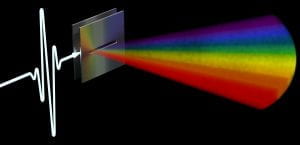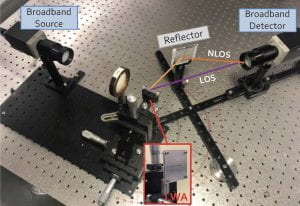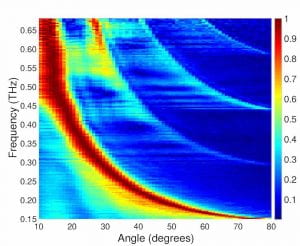In this first year of the project, the first major activity has involved the characterization of the “THz rainbow” that is emitted from a leaky-wave antenna under broadband excitation. We have developed a diffraction model and also a ray-tracing approach which give complementary descriptions of the antenna’s complex radiation pattern. We have employed this understanding to develop a new method for link discovery, in which both angle of departure (AoD) and angle of arrival (AoA) can be harvested simultaneously in a single shot, avoiding the need for an exhaustive sector sweep and thus improving compatibility with low-latency requirements. We have implemented a classifier which operates with high accuracy and can rapidly process a received spectrum to extract both of these quantities. This protocol does not require knowledge of the spectral phase of the signal, but only the spectral amplitude, and therefore does not require synchronization between transmitter and receiver.
Thrust:
One of the thrusts of this project is efficient path discovery and coordination of narrow beams in space, with minimal use of resources that could otherwise be used for transmission. Our objective is to realize the fundamental communication structures and corresponding control planes that overcomes this challenge and can efficiently adapt to client and environmental mobility in THz-scale spectrum.
Major Activities:
The efficient coordination of spatial resources is a fundamental challenge in THz-scale networks with highly directional beams. In particular, given that THz links lack the “pseudo-omni” reception capability available at millimeter wave, conventional techniques from cannot be applied. Moreover, due to their inherently more directional nature (narrow beams of only a few degrees as opposed to tens of degrees in mmWave beams), the number of possible sender-receiver beam pairs is significantly increased, rendering the overhead of exhaustive testing infeasible.
The key activity over the past year was to design, implement, and experimentally evaluate a novel system that identifies high-rate physical paths between the Access Point (AP) and all clients via a single-shot THz pulse transmission hence achieving real-time path information for beam steering purposes.
Specific Objectives:
Due to high path loss in THz bands, only a few dominant paths exist between a pair of nodes, e.g., one line-of-sight (LOS) path and possibly a small number of reflected paths. Our key idea is to transmit distinct signals with unique signatures across different angles such that each physical path has its own signature. To create a unique signature in each direction simultaneously, we introduce a novel THz node architecture in which the AP and clients are equipped with a Leaky Waveguide (LWG). A LWG allows traveling wave to leak from a waveguide into free-space with the unique property that the emission angle from the waveguide is coupled to the frequency of the input signal via a simple closed form and monotonic relationship. We exploit this property in new ways and develop the first LWG-based path discovery system:
First, we create a “THz Rainbow” by exciting the LWG with a time-domain THz pulse (equivalently, a broadband signal in frequency-domain) such that the signal emitted at each angle has a unique signature, thus filling the entire angular space with signal. Namely, each direction has a unique spectral peak or “color” due to the LWG’s frequency-angle coupling.
Figure 1: Creation of a THz Rainbow by exciting a LWA device with a THz pulse.
Second, in addition to its spectral peak, we discover that each direction also has a unique spectral signature. Consequently, we develop a model for predicting the angle-dependent spectral signature, based on the physics of EM waves propagating through and emitting from LWGs. The model is a deterministic function of the LWG geometric properties and thus can be known a priori by the AP and clients. With this design, we allow the receiver to correlate its received portion of the THz Rainbow with the known transmission signatures, thereby identifying the transmission direction of each of the sender’s paths.
Figure 2: Our experimental setup.
Finally, our design is a non-coherent path discovery scheme in that it only requires power measurement at the receiver, and not phase information. This relaxation simplifies the THz node architecture, eliminates the need to keep tight synchronization between the transmitter and receiver, and is robust to small-scale channel variation (as opposed to phase with substantial sensitivity to sub-millimeter scale movement in the THz regime). Moreover, our path discovery in scheme is scalable, such that all clients can simultaneously and independently identify their LOS and NLOS paths via analyzing their received power spectrum from a single-shot transmission of the THz pulse shaped by a LWG.
Rainbow-HM-fNorm-eps-converted-to
Figure 3: Spectrum-Angle heatmap of THz Rainbow.
Significant Results:
We implemented the first single-shot single-antenna path discovery system in THz networks. We conducted extensive over-the-air experiments to characterize the THz Rainbow and evaluate the performance of our design in various indoor settings. Our key findings are:
(i) We experimentally demonstrated a THz Rainbow for the first time and measure its complex spatial-spectral profile. We found that any frequency component within the bandwidth of source emerges from the LWG in a range of emission angles, including but not limited to the angle known from literature. In addition, we observed that the angular span of such emissions is itself frequency-dependent causing a unique spatial-spectral signature at each direction.
(ii) Even though the spectral peak has a one-to-one relationship with emission angle, our experiments revealed that discovering paths solely via this relationship incurs critical limitations: (1) estimation accuracy is not robust across the entire angular range and (2) reflected paths non-uniformly impact power over different frequencies which can lead to a spectral peak shift and subsequent estimation inaccuracy.
(iii) Instead, our design takes advantage of the unique spatial-spectral signatures of the THz Rainbow and achieves average estimation error of < 1.1 degrees for the first path and < 1.9 degrees for the second path.
(iv) Moreover, we exploited the discovered path directions to adapt directional THz beams under client mobility. We found that the non-zero error in path estimates causes slightly misaligned beam steering and subsequent SNR penalty of 0.29 dB on average. Yet, as the time interval between two path discovery measurements increases, the corresponding SNR loss becomes larger. Interestingly, our analysis showed that the time overhead of a THz Rainbow is orders of magnitude smaller than regular client mobility timescales. Hence, the overhead of our design, even if executed before every data transmission, is relatively small.
Publications:
Y. Ghasempour, C.-Y Yeh, R. Shrestha, D. Mittleman, E. Knightly, “Single Shot Single Antenna Path Discovery in THz Networks,” in Proceedings of ACM MobiCom 2020, September 2020.
Y. Ghasempour, R. Shrestha, A. Charous, E. Knightly, and D.M. Mittleman, (2020) “Single-shot link discovery for terahertz wireless networks,” Nature Communications, 11 2017.


